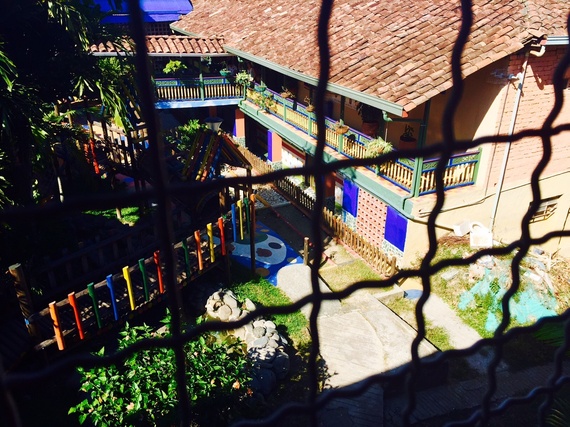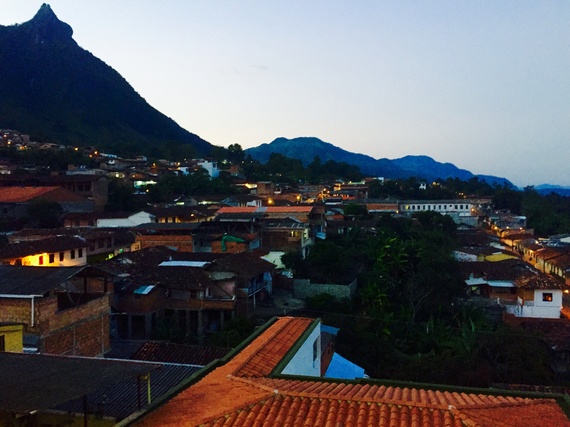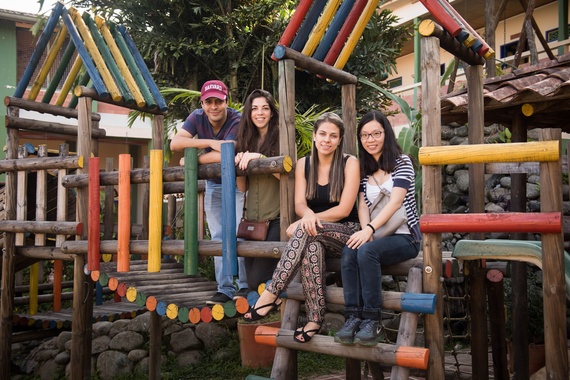By Li Gao, Katrina Keegan, Johan Morales, and Laura Pulgarin
Still groggy with sleep, we boarded our vans to embark on the three-hour journey from Medellin to Támesis, Colombia. The long and winding road lent spectacular views of the Colombian countryside and allowed for some much-needed reflection time. Our team, usually chatty and energetic, tucked into our seats for the long ride, absorbed in our own thoughts. A busy week of lectures, lessons, and site visits began to sink in as we discussed some of the major themes of this trip. First and foremost, as medical and public health students, we are focused on public health promotion and health access among vulnerable communities. A second major theme of exploration is urban renewal and the definition of spaces in the interest of public health. Our third major focus is on education and the empowerment of communities and individuals to make healthy choices. Little did we know that our next destination would be a singular incredible example of success in all of these three areas.
'House of Health (HH)' San Juan de Dios is nestled in the middle of the charming town of Támesis. HH's walls are decorated with colorful murals and feature brightly painted woodwork, artful sculptures, and elegant fountains. Upon arrival, we were warmly greeted by director, Dr. Eduardo Rivera, and welcomed inside to learn about the health center and its impact on the community. Dr. Rivera's passion and pride for his work at the "House of Health" permeates his speech and colors his warm personality. As he described how his vision came to be reality, we recognized our integral themes throughout: health, space, and education.
 View of courtyard in Támesis Hospital, "House of Health." From a public health perspective, the HH San Juan de Dios is on the cutting edge of progressive innovation. Its comprehensive population-based approach, widespread outreach and exceptional impact far exceed its mandated duties as a "level one" (lowest level) health center. Dr. Rivera attributes this to one thing: conviction. Specifically, he described a shared conviction to promote healthy lives that begin before birth and last a lifetime. This reality was achieved by challenging traditional notions of hospital function and management. He describes that on any given day, hundreds of children and their families are at the hospital; not because they're sick, but because the hospital is the heart of the community, with health promotion at its core. Early on, Dr. Rivera and his team focused on building health programs for early childhood. The health center came alive with children each day and their families soon followed, creating a social investment in the facility and thus, a continual and personal investment in health. Today, the intimate interaction between staff and patients within the health center allows prompt detection of warning signs among the children and early health interventions. The hospital incites opportunities for health at every corner, featuring gorgeous recreation areas and gyms, a spa and sauna, mental health and psychiatry facilities, and a healthy meal program.
View of courtyard in Támesis Hospital, "House of Health." From a public health perspective, the HH San Juan de Dios is on the cutting edge of progressive innovation. Its comprehensive population-based approach, widespread outreach and exceptional impact far exceed its mandated duties as a "level one" (lowest level) health center. Dr. Rivera attributes this to one thing: conviction. Specifically, he described a shared conviction to promote healthy lives that begin before birth and last a lifetime. This reality was achieved by challenging traditional notions of hospital function and management. He describes that on any given day, hundreds of children and their families are at the hospital; not because they're sick, but because the hospital is the heart of the community, with health promotion at its core. Early on, Dr. Rivera and his team focused on building health programs for early childhood. The health center came alive with children each day and their families soon followed, creating a social investment in the facility and thus, a continual and personal investment in health. Today, the intimate interaction between staff and patients within the health center allows prompt detection of warning signs among the children and early health interventions. The hospital incites opportunities for health at every corner, featuring gorgeous recreation areas and gyms, a spa and sauna, mental health and psychiatry facilities, and a healthy meal program.
 "House of Health" has fifteen different spaces in its daycare area. Each space is dedicated to different activities. One of this spaces has a small stage were teachers and students dress up and learn through acting.In addition to health promotion, education is finely woven into the hospital's fabric. As we toured the open-aired corridors, we were welcomed into different classrooms, each with their own unique character, theme, and décor. In one room, we were handed wooden sticks and minutes later found ourselves part of an impromptu musical ensemble, led by an energetic music teacher. In the next room, we entered a dark theater space and experienced a performance by two impassioned drama teachers who had us on our feet and singing aloud. In yet another room, we found ourselves in a world of miniature furniture and toys, designed to engage toddlers in meaningful play and learning. Lessons in health and wellbeing were infused into every space and activity. Dr. Rivera reiterated that on any given day, hundreds of children rotate through the myriad classrooms and recreational spaces, and in time, by their siblings and parents, an unprecedented and savvy strategy to engage the entire population.
"House of Health" has fifteen different spaces in its daycare area. Each space is dedicated to different activities. One of this spaces has a small stage were teachers and students dress up and learn through acting.In addition to health promotion, education is finely woven into the hospital's fabric. As we toured the open-aired corridors, we were welcomed into different classrooms, each with their own unique character, theme, and décor. In one room, we were handed wooden sticks and minutes later found ourselves part of an impromptu musical ensemble, led by an energetic music teacher. In the next room, we entered a dark theater space and experienced a performance by two impassioned drama teachers who had us on our feet and singing aloud. In yet another room, we found ourselves in a world of miniature furniture and toys, designed to engage toddlers in meaningful play and learning. Lessons in health and wellbeing were infused into every space and activity. Dr. Rivera reiterated that on any given day, hundreds of children rotate through the myriad classrooms and recreational spaces, and in time, by their siblings and parents, an unprecedented and savvy strategy to engage the entire population.
Entering the hospital wing, we were greeted by friendly faces and a comprehensive color-coded chart on the wall; clearly detailing various health functions, expected waiting times, and associated costs. We toured each part of the hospital, awed by the colorful wood-work, stained-glass windows, and immaculately clean patient rooms and laboratory. The few patients admitted at the time received first-class attention and individualized care. Walking around this hospital, we felt at home. Contrast this to a typical hospital setting: white-washed walls, overburdened staff, crowded waiting rooms, and a bustle of activity. Not here. Dr. Rivera and his team has transformed our notions of a typical hospital and created an atmosphere for health and healing. Our lessons in urban spaces resonate here. Before us stood a model of urban recycling and innovative use of public space to provide comprehensive services.
The program at Támesis has been in progress for 15 years and its results speak for itself. Doctors and nurses we spoke to described how children who regularly attend the center have fewer and less severe health problems as a result. In fact, its rigorous focus on public health and prevention has caused a decline in the number and severity of hospitalizations since the programs' initiation. This also has financial benefits, as having fewer admissions saves the hospital money, which is immediately re-invested into its health programs, facilities, and staff. This cyclical process feeds into itself, improving the health of over 16,000 inhabitants of the greater Támesis community. Most recently, chivas (colorful Colombian country buses) were introduced to extend health care access to those outside the city center.
Dr. Rivera and his team have turned a hospital into a home for an entire community. It struck us how this space, usually reserved for sickness and temporary visits, was transformed into a social and cultural destination at the heart of the community. This hospital has proven that conviction can make powerful changes in community empowerment, social cohesion, and health on both an individual and population scale.
With the model of Támesis in mind and an invigorated conviction, it's time for us to create our own changes. Working together with the community, we're building public health projects aimed at improving the health of Granizal, Colombia. HH San Juan de Dios is a unique and inspiring example of public health reform in Colombia and they have proved that positive change is possible. We believe that it serves as a public health example for the world.
This post is part of a series entitled "Post-Conflict Colombia and Public Health" a project of the Open Hands Initiative and the Harvard Humanitarian Initiative, in collaboration with the School of Medicine - Universidad de Antioquia. For more information about the project, read here.


